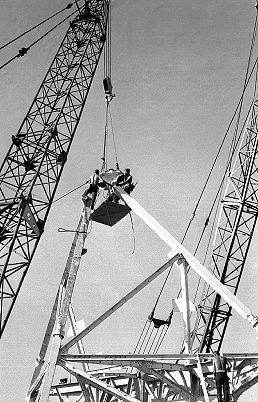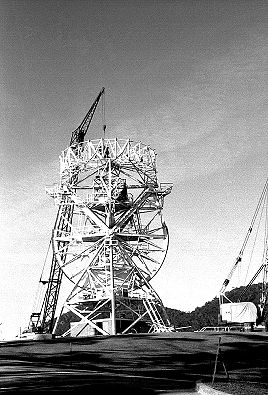Honeysuckle Creek Tracking Station
(abbreviated as HSK) was built by the Australian Government for the Manned Space Flight Network.
The contract for construction of the station buildings, antenna foundations, power house, etc., was let to Canberra-based builder T.H. O’Connor in 1965. The work was completed in December 1966.
The 26 metre antenna was erected by Collins Radio under contract to NASA’s Goddard Space Flight Centre (GSFC) and the equipment was installed by the joint effort of station and GSFC staff.
It cost around $A2,000,000
(in 1966 money) to build and had an annual running budget of $1,250,000.
See also footage of construction.
|
The three stages of Honeysuckle Creek.
This advertisement for the builders, T. H. O’Connor Pty Ltd., appeared in the June/July 1967 issue of SCODOS, the Department of Supply’s magazine.
Large, Larger.
With thanks to the Department of Supply’s Richard Collins.
Scan: Colin Mackellar. |
|
Left to right: Ernie McLean; Tommy (T.H.) O’Connor, building contractor; E. Greenfield.
This photo was taken at Orroral Valley, near that station’s Collimation tower track, in October 1964.
T. H. O’Connor Pty. Ltd was involved with the construction of Tidbinbilla, Orroral Valley, and Honeysuckle Creek Tracking Stations (and many Canberra buildings).
Photo from the Tidbinbilla archives. Scan: Colin Mackellar.
|
|
By 19 November 1965, the buildings are just beginning to take shape.
The skeletons of the Powerhouse, at left, and the Operations Building, centre-right, are in place. The circular roadway around the antenna pad can be seen at far right, but the antenna is yet to be built.
This view is from the water tank on the ridge to the SSE of the station.
From the Tidbinbilla station archive. Scan and image repair by Colin Mackellar.
See other photos taken from the water tank. |
|
Honeysuckle Creek under construction.
This photo was taken 25th February 1966,
the day Orroral Valley Tracking Station was opened.
Members of the official party from that event toured Honeysuckle on their way to Tidbinbilla.
It’s fairly early in the construction of the Operations Building, with scoffolding still in place.
Looking from above the car park – the antenna was being assembled to the left of the photographer’s position.
See also the clearing for the Collimation tower (not yet erected) in the distance at right.
Large, Largest (1.4MB).
Scanned by Colin Mackellar from Lloyd Bott’s Orroral Valley souvenir photo album.
|
|
Honeysuckle Creek under construction.
Also taken 25th February 1966. The antenna has not yet been started.
Left to right:
1. ???;
2. Ian Homewood (Department of Supply);
3. ??? ;
4. ???;
5. Don Wood DoS (?);
6. ???;
7. Alan Cooley (the Secretary of the Department of Supply);
8. US Congressman George P. Miller (California);
9. ???;
10. Edmond C. Buckley (OSTDS – NASA’s Office of Space Tracking and Data Systems);
11. Lloyd Bott (Deputy Secretary Department of Supply).
Note the builders offices of T H O’Connor, the Department of Works contractor. This hut was built in what was later the car park.
With thanks to Tom Reid for help with identification.
Large, Detail (500kb).
Scanned by Colin Mackellar from Lloyd Bott’s Orroral Valley souvenir photo album.
|
|
Two prime movers were needed to haul the counterweight for Honeysuckle’s 85 foot (26 metre) antenna up the steep and winding track along Deadman’s Hill, mid-1966.
From the SCODOS (the Department of Supply’s magazine) annual report, 1966.
Magazine preserved by Philip Clark. 2022 scan by Colin Mackellar. |
 |
 |
| The antenna west base legs in place. |
A medium shot of the X axis bearing being
installed. |
 |
 |
The X and Y axes have been built, and the parabolic
dish support structure is being assembled. The bottom photos would be May 1966, from comparison with the video below.
Hamish Lindsay writes – “These pictures were taken by Ken Lee and he gave me the
35mm negatives.”
News scans of the full set of negatives coming soon (June 2022).
|
|
Honeysuckle Creek as seen from the driveway, probably late-1966. The Acquisition dish has not yet been installed at the apex of the quadripod.
Screenshot by Colin Mackellar from film shot for The Vital Link. (With thanks to Mark Gray for this transfer.) |
|
|
|
“I am standing on top
of the antenna quadlegs at the very top of the antenna looking down
on Ian Anderson installing cables for the Acquisition dish, not
yet installed. In the background you can see the main building.
It is very early days, late
in 1966, as the building contractor’s sheds are still in place,
and the flags are not flying, so it’s probably before we received
them.” [Also, the microwave tower has not been bult.]
Photo and notes by Hamish Lindsay. |
Hamish
Lindsay remembers –
“The original USB equipment and antenna servos
were installed by Collins Radio and they had a shed put up beside the antenna
they labelled ‘Casa de Collins’.”
|
|
|
Here is it behind the antenna. The sign, “Casa de Collins” is just visible above the door.
Detail from a photo of the MSFN Inspection Team at Honeysuckle Creek, 6th January 1967.
Photo: Hamish Lindsay. Scan: Colin Mackellar. |
Honeysuckle was managed by the Goddard Space Flight
Centre in Greenbelt, Maryland and was run by Standard Telephones & Cables
Pty. Ltd. (and later Fairey Aust.) on behalf of the Commonwealth Department
of Supply.
Engineers, technicians, computer specialists and
many others were recruited to run the station. Around 90 people worked at Honeysuckle
during the Apollo Program and a little more than a hundred during Skylab.
All of the equipment was shipped in from the US.
(Being far from any Australian power supply, the station’s power was entirely
110V at 60Hz, ensuring interchangability with other NASA equipment.)
While the equipment came from NASA, the local team
was responsible for running the station.
(Read the agreement between the US and Australian
governments covering all US tracking stations in Australia here.
– This link is to the 1970 agreement.)
|
|
|
Hamish Lindsay writes
“An aerial shot of HSK in
1966. I took this from a helicopter that was on a trial flight to
see if it was practical to evacuate badly injured staff members from the
site.” |
|
|
The Honeysuckle Operations building,
with the antenna up the hill just above it, shortly after construction.
The absence of Australian and US flags
suggests it was taken before the official opening.
Photo by Hamish Lindsay, scan by
John Saxon. |
|
|
Another photo from before the opening.
Photo: Bruce Withey.
|
|
|
This view from the south shows the antenna and the main
building surrounded by granite boulders and gum trees.
The microwave tower
linking Honeysuckle with Tidbinbilla is just visible at the left and of
the main building.
Photo: Hamish Lindsay.
Other photos from the same location may be seen here. |
So who owned Honeysuckle?
Mike Dinn contributes –
Who owned Honeysuckle?
- The Department of Supply (or Science, or Manufac Ind)
owned it, being the Australian Govt Agency responsible, and so supplied
the Director, Deputy and Admin/Finance officer.
- Tom Reid ‘owned’ it, because he was the Director, and
didn’t care which Australian Govt agency might be nominally in
charge at any time (Supply, Science, Science and Technology,
Manufacturing Industry, CSIRO).
- STC (or AWA or Fairey) ‘owned’ it because all the staff
(except 3 DOS) were their employees.
- The staff (contractor and DOS) owned it, because it
didn’t matter who the various public and private organisations
responsible were. All THEY had to do well was to be a good conduit for
pay and other money from NASA.
- NASA owned it because they paid every dollar spent
there.
- Goddard owned it, because they were responsible for
the engineering (Spec, installation, maintenance, modification) and
operations logistics and training and budgets, etc.
- The American Projects Branch, American Projects Division
(Dept of Supply), Australian Space Office, being the day to day responsible
org.
- Houston owned it, because it was there to support
their missions.
|



